If you’re keen to venture over to Turkey and you’re unsure about when the best time to visit Turkey is, I’ve listed all the information you need to know about the best time to go to Turkey.
I have covered all of the tips I wish I had known before I started traveling Türkiye, such as when you can find the best weather to visit Turkey, the best month to travel to Turkey, and what summer in Turkey is like.

Skip Ahead To My Advice Here!
When Is The Best Time To Visit Turkey
Deciding on the best time to visit Turkey really hinges on what you’re looking to get out of your trip.
Shoulder Season
If you are keen on mild weather and thinner crowds, the shoulder seasons of April and May or between September and November are typically the best times to explore.
During these months, you can enjoy the start of spring or the crispness of fall, perfect for wandering through the historical sites of Istanbul and exploring the natural wonders like the fairy chimneys of Cappadocia.
December To February
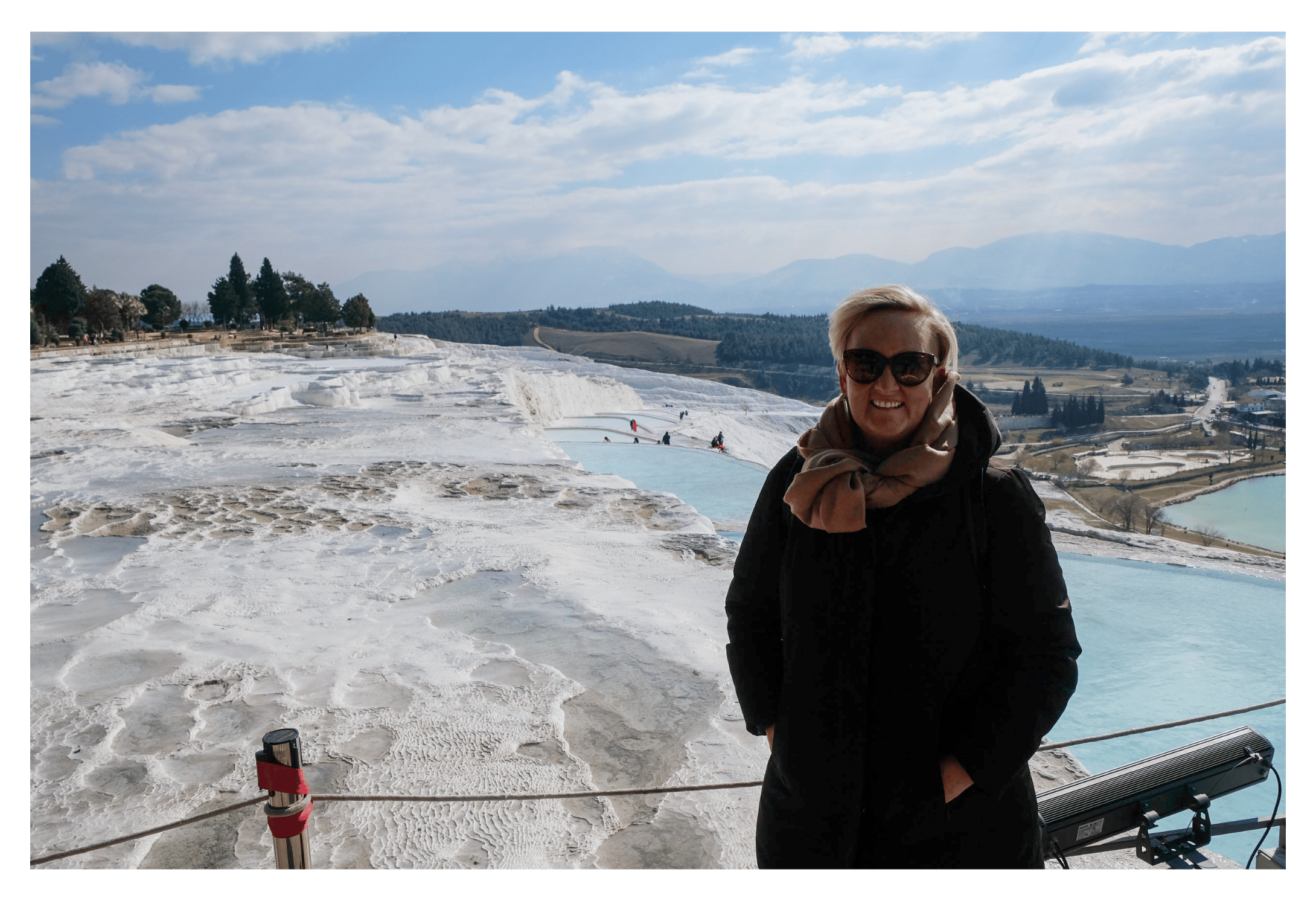
If you’re considering a winter visit, December through February offers a different kind of charm, especially if you’re into skiing or snowboarding. The mountain resorts near Bursa and in the eastern parts of the country, like Erzurum, come to life, providing snowy adventures against stunning backdrops.
Cities like Istanbul might be chillier and sometimes snowy. Still, they’re less crowded, allowing for a more leisurely exploration of its cultural treasures and the chance to experience traditional Turkish baths and cozy cafes.
Summer In Turkey
Summer, from June through August, is the peak season, especially on the Aegean and Mediterranean coasts – it is VERY crowded during this time. But this is the best season for sun-seekers and beach lovers who want to bask on the sands of the Turkish Riviera, enjoy water sports, or explore the underwater ruins off the Turquoise Coast.
The weather can get quite hot, especially in the interior, so it’s a time best suited for those who like it warm and are eager to enjoy the vibrant nightlife and bustling bazaars. Summer festivals and open-air concerts add to the allure, offering something for every traveler.
Whether the call of the outdoors draws you, the lure of ancient cities, or the relaxation of seaside resorts, Turkey’s diverse climates and cultural offerings ensure there’s an ideal time for every type of traveler to visit.
It’s easy to assume that Türkiye is just a place to go on vacation in summer. It’s no surprise that we see countless photos and adverts about Turkey’s stunning beaches, so we automatically associate summer with it.
Traveling In Turkey Climate Guide
So when is a great time to visit? Here is what the weather is usually like (I mean, nothing is guaranteed) for the main places to visit in Turkey.
| Region | Winter (Dec – Feb) |
Spring (Mar-May) |
Summer (Jun – Aug) |
Autumn (Sep – Nov) |
|---|---|---|---|---|
| Mediterranean Coast | 10°C / 50°F 15°C / 59°F |
15°C / 59°F 25°C / 77°F |
30°C / 86°F 35°C / 95°F |
20°C / 68°F 25°C / 77°F |
| Eastern Turkey | -10°C / 14°F 0°C / 32°F |
5°C / 41°F 15°C / 59°F |
20°C / 68°F 30°C / 86°F |
5°C / 41°F 15°C / 59°F |
| Black Sea Coast | 5°C / 41°F 10°C / 50°F |
10°C / 50°F 20°C / 68°F |
20°C / 68°F 25°C / 77°F |
15°C / 59°F 20°C / 68°F |
| Central Anatolia | -5°C / 23°F 5°C / 41°F |
10°C / 50°F 20°C / 68°F |
25°C / 77°F 30°C / 86°F |
10°C / 50°F 15°C / 59°F |
Perfect Months To Travel To Turkey
As I mentioned, the best time to visit Turkey depends on what you like to do. Here are some ideas for the times of the year that might suit your travel plans.
June to August
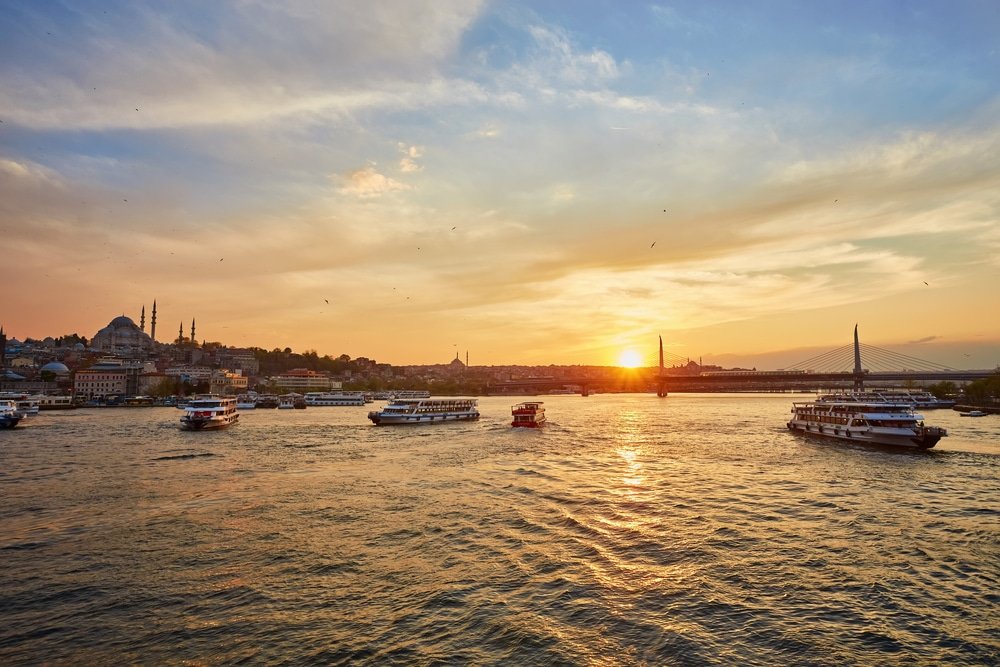
Bosphorus Cruises in Istanbul. For a different angle on Istanbul’s beauty, hop on a Bosphorus cruise. These summer months offer the perfect climate for a leisurely boat ride, letting you take in the city’s skyline from the cool, refreshing waters. It’s a relaxing way to see the city’s sights, from ancient palaces to modern bridges, with a sea breeze to keep you company.
Southern Coast. If you’re eyeing some sun, sea, and sand, June through August is your window. Turkey’s southern coastlines are at their prime, boasting perfect weather for any and all beach activities. Whether you’re looking to chill by the Mediterranean or the Aegean Sea, these months promise postcard-perfect beach days.
March to May
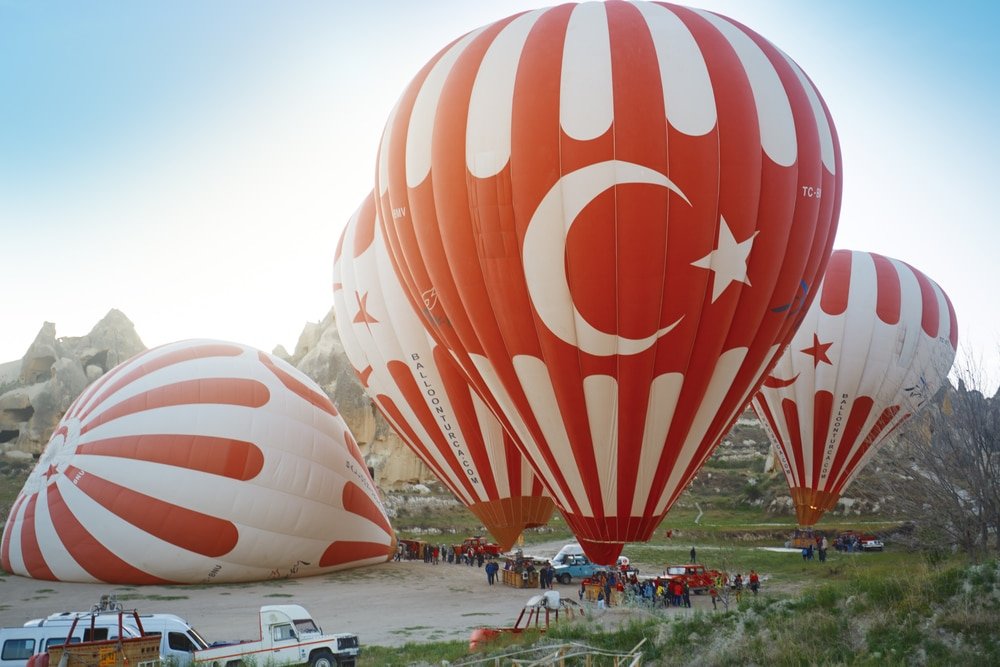
Istanbul and Cappadocia. Spring in Turkey? Absolutely, especially for Istanbul and Cappadocia. Istanbul springs to life with vibrant colors, minus the heavy tourist traffic. And Cappadocia? Thanks to the mild weather, it’s prime time for those dreamy hot air balloon rides. It’s definitely a double-whammy destination if there ever was one.
Ephesus. For a walk through history without breaking a sweat, March to May is your go-to for visiting Ephesus. The weather’s on your side, letting you explore those ancient ruins in comfort. It’s the ideal season for history buffs to take their time wandering through this historic gem.
November to March

Ski Resorts. Craving some snow? Turkey’s mountain ranges, like Erciyes and Uludağ, are calling your name from November to March. They offer top-notch skiing with a side of breathtaking winter scenery.
Thermal Spas of Pamukkale. For a different kind of warmth, hit up Pamukkale’s thermal spas during these cooler months. Imagine dipping into warm, mineral-rich waters while everything around you is cool and crisp. Less crowded, more serene – it’s a slice of relaxation heaven.
September to October
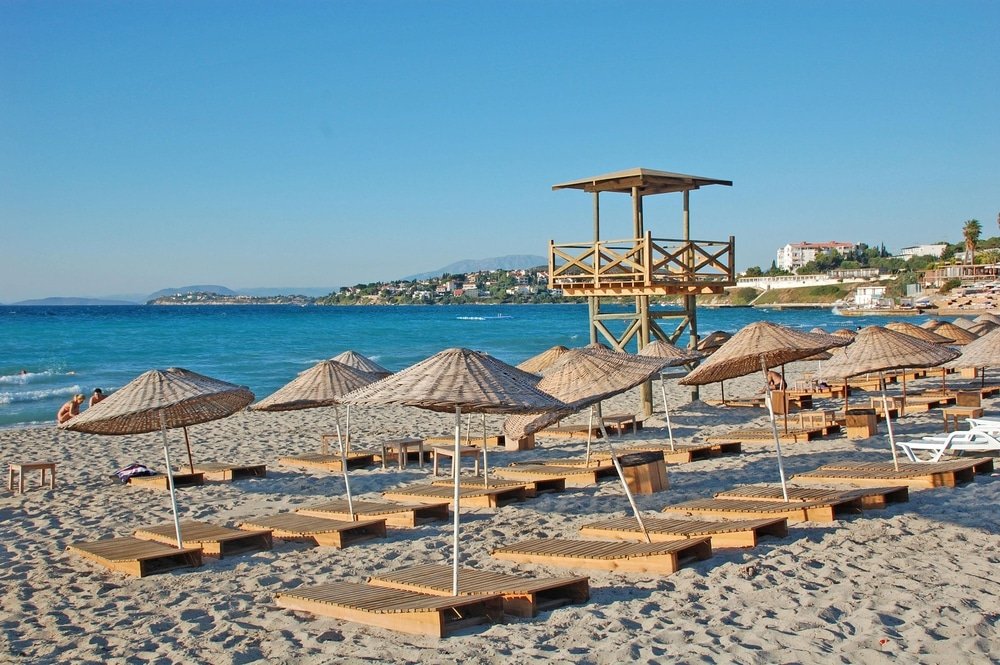
Aegean Coast. The Aegean Coast shines bright in the autumn months. The weather’s still warm, but the summer crowds have thinned out, giving you a more relaxed vibe to explore ancient sites like Ephesus or enjoy the scenic views.
Grape Harvest in the Aegean Wine Regions. Wine aficionados, take note. September and October mean grape harvest season along the Aegean coast. Vineyards open their doors for tours, tastings, and, sometimes, a chance to join in the harvest. It’s a unique way to experience Turkey’s wine culture against a backdrop of autumn’s golden hues.
September to November
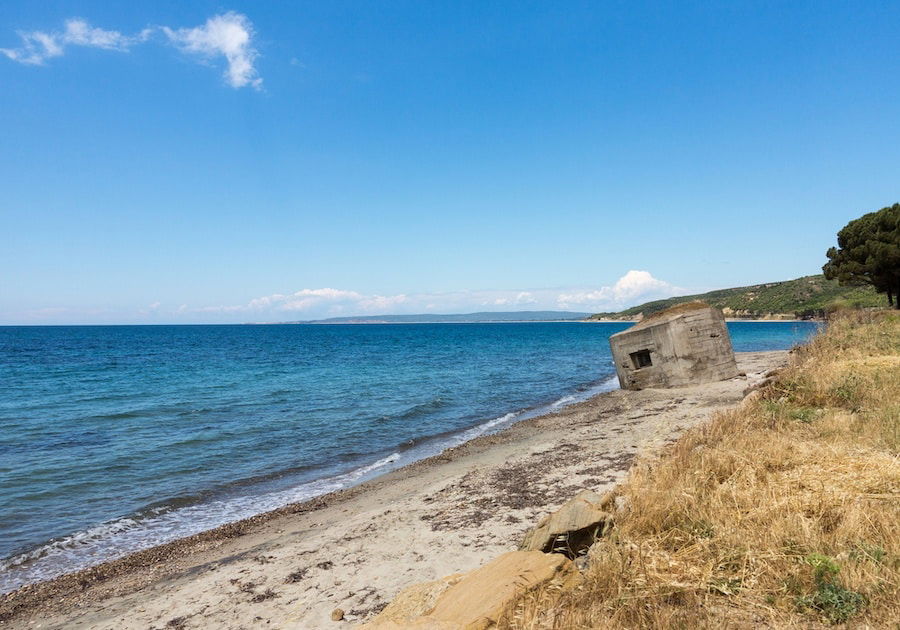
Cappadocia. For the hot-air balloon enthusiasts, October and November in Cappadocia offer cool, stable weather perfect for flying. The skies are clear, offering unrivaled views of the landscape’s unique formations.
Gallipoli. These months also present a quieter, more contemplative time to visit Gallipoli. The weather is mild, which is ideal for taking the time to understand the historical and emotional depth of this significant site.
Turkey is huge, which means there are plenty of destinations across different climates—so let’s explore some of them.
Brands We Use And Trust
Area By Area Travel Guide
Best Time To Visit Bodrum
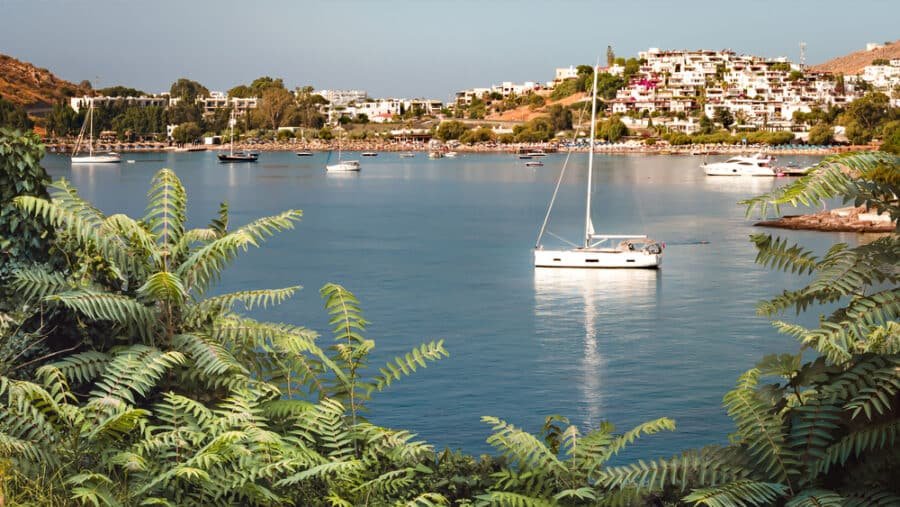
Bodrum is an upmarket holiday resort located on the southwest coast that’s become extremely famous over the last few years. Many celebrities have been spotted in Bodrum, especially sailing around its stunning coastline.
When you visit Bodrum, you can expect summer fun with plenty of beach time, vibrant nightlife, and fantastic gastronomy.
Weather In Bodrum

- November to February: Cool (but not freezing) temperatures, with a high chance of rain. January is usually the coldest and wettest month, with an average temperature of around 10 degrees Celcius (50°F) and night times dipping to about 5 degrees Celsius (41°F). The odd storm may also bring wind and rain for a few days at a time
- March to May: This is considered spring, and at this time, you can expect very warm temperatures with less rain. However, it’s not really beach weather just yet, as the sea is very chilly! By the end of May, you can certainly wear your summer clothes
- June to August: Hot! This is the peak summer months, especially July and August. Temperatures can climb into the 40s, and rain is virtually non-existent. You will need air conditioning at this time as evenings only dip to around the high 20s
- September to October: Temperatures are starting to cool down, and this is a very pleasant time to visit Bodrum. There is still very low rainfall; however, as you move into October, short-lived showers are likely. Thankfully, the evenings start to cool.
Bodrum General Life
Bodrum is an all-year-round destination; however, don’t expect to be able to get in the sea during the winter months! Between November and April, Bodrum is a lot quieter, but it’s a nice vibe, and you’ll be able to explore the local area a lot easier than if you were visiting during the summer.
Many touristic bars and restaurants will be closed, but that certainly doesn’t mean all; Bodrum is quite a thriving city, and during the weekends, you’ll find vibrant nightlife on offer.
What To Pack For Bodrum
If you’re visiting during the shoulder months, take a light jacket or cardigan for the evenings. However, during the summer months, you certainly won’t need that!
During the winter, you will need a coat and boots, especially if it rains. Although you’re very unlikely to see snow, that doesn’t mean you might not encounter a winter storm or two.
Best Time To Visit Izmir
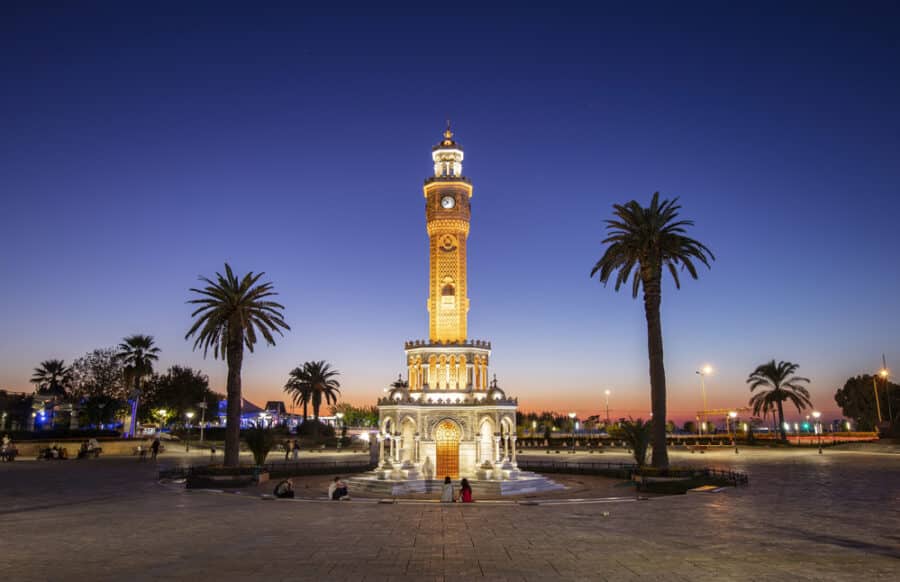
Izmir is Turkey’s third-biggest city, and that should tell you a lot about what it has to offer! It has a very young vibe, as it’s a large university spot, but it’s also a city for everyone, with history and culture at every turn.
Weather In Izmir
Izmir’s weather is very similar to that of the coastal resorts, as it’s a coastal city in its own right. Sitting on the shore of the Aegean, you can expect plenty of swimming opportunities during the summer months. Even during the winter, you can expect relatively mild temperatures.
- November to February: During this month, you may experience rain and the odd storm coming over the Aegean. This may bring heavy rain and wind but normally only lasts for a day or two. For the rest of the time, temperatures are relatively mild for the time of year, with the lowest temperature being around 10 degrees Celsius (50°F). Nighttimes can be cold, however
- March to April: Spring has sprung! During this time, the weather is warming up, and there are some very pleasant days when you may be able to walk around in a t-shirt. There may be occasional days of rain, but these tend to be short-lived
- June to August: Izmir has very warm summer days so that you can expect high 30s-low 40s at this time. Evenings are very warm, never really dipping below 25 degrees Celcius (77°F). Rain is very unlikely
- September to October: As with Bodrum, the weather at this time is starting to cool, and there are some pleasant days, a little like spring. Rain may occur as October arrives, but this is unlikely to be heavy.
General Life In Izmir
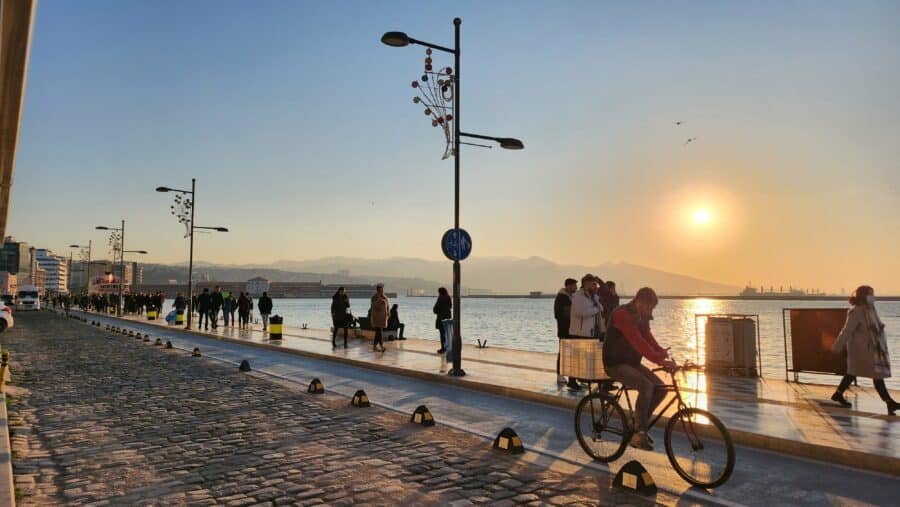
Izmir is busy no matter the month; however, you will notice that it gets even busier from June to August when people flock to the coast to cool down during the hottest period of the year.
Restaurants, bars, and tourist attractions remain open all year round.
What To Pack For Izmir
If you’re visiting Izmir during the winter months, certainly take a coat and umbrella as you may face rain and cooler days. However, for the spring and autumn months, a light jacket may be enough, with an umbrella in your bag, just in case.
During the summer months, umbrellas aren’t needed, and only comfortable shoes for walking around in the sunshine!
Best Time To Visit Antalya
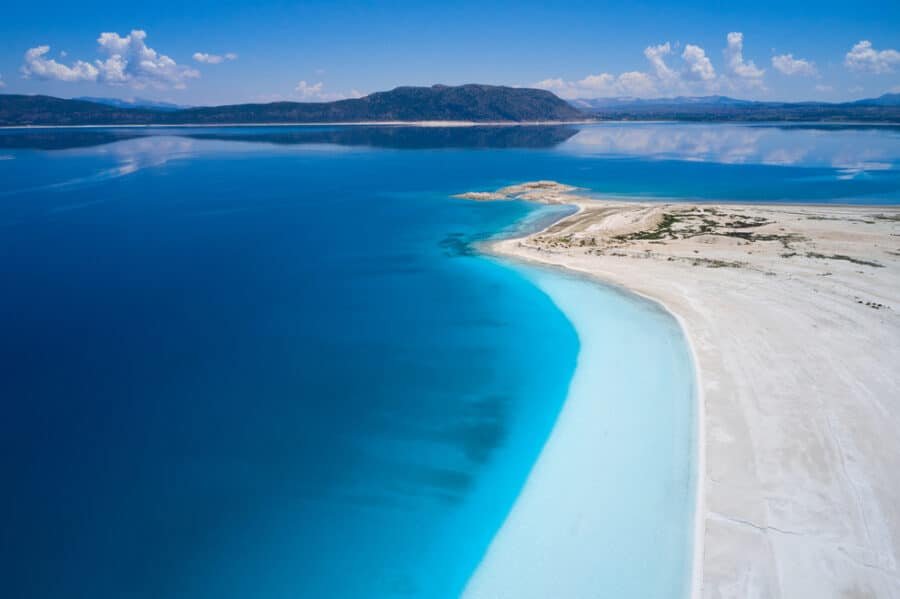
Located on the south coast, Antalya gets the country’s hottest and driest weather. The difference between this region and the other holiday resorts is that the summer season lasts a little longer, thanks to the region’s proximity further east.
However, Antalya is also one of Turkey’s most famous regions, packed with amazing beaches, historical sights, and areas of natural beauty. It’s also worth mentioning that Antalya is both a city and a province, so the area is HUGE.
Weather in Antalya
- December to February: During these months, Antalya is in winter mode, and you will see snow on the high mountains; however, it’s unlikely to reach lower levels. Rain can be quite prominent during these months, along with lower temperatures, however, you’ll also see many mild days too
- March to May: Antalya quickly starts to warm up as spring arrives, and particularly into April, you’ll notice that temperatures are in the double figures. There may still be rain, but showers are likely to be short-lived. Evenings will be chilly at this time, so a thin jacket is needed
- June to August: The summer months in Antalya are scorching indeed, often reaching into the 40s, with zero rain. Evenings are also very warm, so you’ll need air-conditioning if you want to sleep
- September to November: Antalya’s extended summer season means that it’s usually quite pleasant to swim in the sea until the middle of November. Temperatures stay in the mid-30s until close to the end of November, with a very steep drop after that time. Evenings will become cooler into October, but that may be a welcome break from the heat!
General Life In Antalya

Remember that Antalya is a huge area and includes both a city and several resorts. The resorts are likely to be very quiet during the winter months. You’ll find some bars and restaurants open, but their hours are likely to be reduced, including any touristic attractions that remain open. Yet in Antalya city, you’ll find everything is business as usual, except for the area around the castle, which tends to be less busy during the winter, with some spots closed.
During the summer months, it’s all action. Antalya gets very busy during this time, and you’ll find it hard to find much space for yourself – however, that’s not a reason not to go and enjoy yourself!
If you prefer a slower pace of life but still with great weather, the spring or autumn months are best for you.
What To Pack For Antalya
There are occasional storms during the winter months, and it can get very cold at this time, so make sure you pack a warm coat and suitable shoes. However, if you’re visiting during the spring, summer, or autumn months, you’ll not have to worry much about the chance of rain, and you’ll only need a light jacket for chilly evenings early in the year or later on.
Best Time To Visit Istanbul

Turkey’s biggest city is packed with things to see and do. One visit to Istanbul is never enough, and it’s important to plan your visit so you can get the most out of your time.
You should also manage your expectations in terms of what you’ll be able to see, as traffic and getting around the city is not particularly fast! It’s also a very tiring yet extremely rewarding place to go.
Weather In Istanbul
Istanbul’s weather is tough to predict. Located in the northwest of the country, it is influenced by many elements, including the Black and Marmara Seas.
However, Istanbul does have seasons, which makes it easier to plan.
- November to February: During the winter months, you can expect rain and even snow at times. Temperatures can be very cold, and the wind off the Bosphorus can be biting. However, to throw confusion into the situation, you can also get very mild days too with plenty of sun!
- March to April: The spring months can often bring days of rain, but when the sun is shining, it can be very warm indeed. You will still need a jacket for those days when the cold decides to return and especially for the evenings
- May to August: Summer in Istanbul can be very warm, but not as hot as the south coast resorts. The temperature can reach the mid-30s (95°F), yet there is always a chance of rain, sometimes quite heavy for a time. Evenings will be milder yet still sticky
- September to October: The autumnal months in Istanbul can be a very mixed bag, but it’s rarely very cold. The main feature here is rain; it can rain at any time, so always keep an umbrella with you in your bag. Again, you’ll need a thin jacket for the evening
General Life In Istanbul
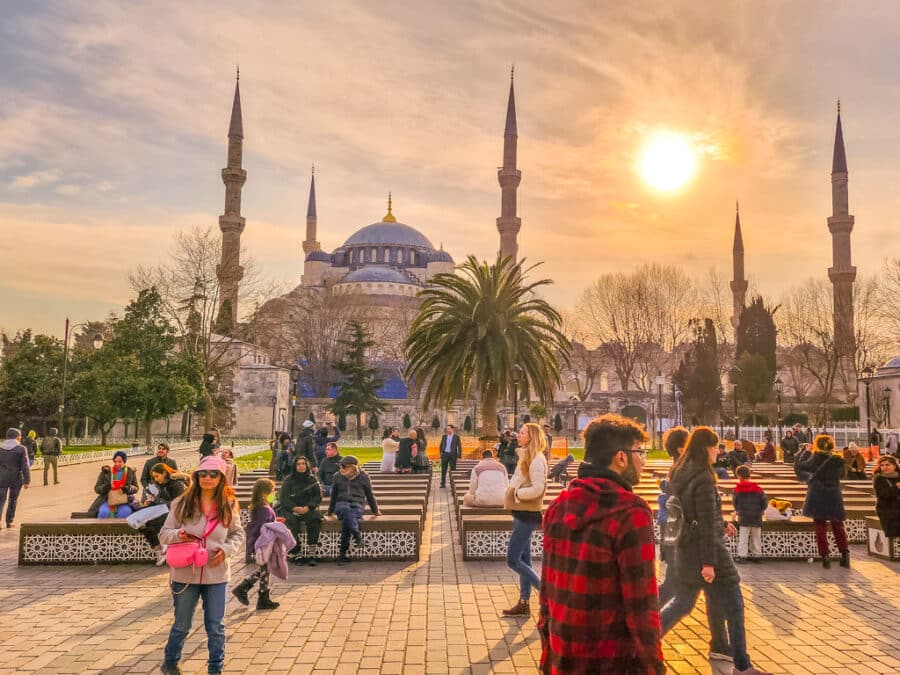
Life never changes in Istanbul. It’s always busy, regardless of the month! However, you will notice that more people from overseas tend to visit Istanbul during the winter months because of the beautiful snow scenes!
In all honesty, it’s easier to visit Istanbul when it’s cooler; when you add high temperatures to a busy city, your experience may be a little stressful. But if you take your time, you should be fine.
All tourist attractions, bars, restaurants, and shops remain open year-round.
What to Pack For Istanbul
Ah, Istanbul packing! You will need a bit of everything! In the primary winter months, you’ll need a very thick jacket and suitable shoes, preferably boots. The only time you won’t need a coat is during the high summer months, but for the rest of the time, it’s a good idea to take on.
It’s not the best idea to walk around Istanbul in sandals or flip-flops—this is a huge city, and your feet will tell you if you try to walk in unsupportive shoes!
The best route here is layers. That way, you’ll never be too hot or cold. Oh, and an umbrella no matter what the month.
- Exploring Istanbul With Kids
- Istanbul Beaches
- Here Is How Many Days In Istanbul Is Enough
- Where To Eat In Istanbul
- Best Hammam In Istanbul
- 4 Days In Istanbul Itinerary
- 16 Things To Do In Istanbul, Turkey
- Whirling Dervishes In Istanbul
- Your Guide To Sultanahmet Istanbul
- Top Palaces In Istanbul
- 48 Hours In Istanbul
- Is Istanbul Safe
- 18 Best Mosques In Istanbul
- Istanbul Nightlife
- Shopping In Istanbul
- Where To Stay In Istanbul
- Best Hotels In Taksim Square In Istanbul
- The Best Festivals in Istanbul
- A Day In The Colorful Balat Istanbul
- Best Museums In Istanbul
- Top Hotels Near The Blue Mosque
- 5 Biggest Istanbul Tourist Scams To Avoid
- Best Breakfast In Istanbul
- Romantic Places In Istanbul
- Things To Do In Istanbul In Winter
Best Time To Visit Cappadocia

Cappadocia is one of the country’s most famous attractions, and it is located in Central Anatolia. The closest city to Cappadocia is Nevsehir, which is not the most accessible place to reach, but you can take connecting flights from Istanbul and save some time.
Weather In Cappadocia
- November to March: Cappadocia experiences very cold winters, which often feature heavy snowfall. Of course, this gives fantastic scenery! Snow can occur as early as November, but you don’t usually see it settling on the ground until the middle of December, lasting into March
- April to June: Spring in Cappadocia is a beautiful time, but the early part of the season will require a coat, as it may still snow, and it’s likely to be quite cold. As you move into May and June, rain is unlikely to be a problem; the occasional shower will be very short-lived, and you’re looking at average daytime temperatures of around 15-20 degrees Celsius (59-69°F)
- July to September: Summers in Cappadocia are very warm but not as hot as in other parts of the country. However, they are very dry, so you won’t have to worry about rain. Temperatures can reach the high 30s in some cases, but as you move into September, they will start to cool
- October to November: Autumn is a beautiful time to visit Cappadocia, with cooler temperatures and fewer crowds. Temperatures are around 20-25 degrees Celcius (69-77°F) on average, with cooler evenings making sleeping much more comfortable. Rain is possible as November arrives, but not particularly heavy
General Life In Cappadocia

Cappadocia is a year-round attraction, so no matter what month of the year, everything will be open as normal. You will find that most people tend to visit during the summer months, but winter can be a beautiful time to experience incredible scenery.
However, if you’re keen to go in a hot air balloon, I recommend that you be aware that poor weather may cancel your flight at the last minute, leaving you disappointed.
What To Pack For Cappadocia
You will need suitable footwear and a thick coat during the winter and into early spring. It can be freezing during this time. A light evening jacket is a sensible idea as summer arrives, but you won’t have to worry about rain.
If you plan on exploring the region, pack walking boots or high-quality trainers; Cappadocia isn’t a flip-flop or sandal place.
Move This Adventure To Your Inbox & Get An Instant Freebie

No spam. Unsubscribe at any time.
Trip To Turkey FAQs
What is the weather like in Turkey in October?
In October, the weather in Turkey is generally mild and pleasant. The coastal areas are still warm, and it’s a great time for sightseeing.
What is the best time to visit Cappadocia?
The best time to visit Cappadocia is during the spring (April to June) and autumn (September to November) when the weather is cool and the landscapes are beautiful.
When is the best time to visit Istanbul?
Istanbul is enjoyable to visit in the spring and autumn when temperatures are moderate, and there are fewer crowds compared to the summer months.
When is the best time of year to visit Turkey overall?
Overall, the best time to visit Turkey is during the spring and autumn seasons, as the weather is pleasant and there are many festivals and events.
Is Turkey hot in November?
Turkey’s temperature in November varies across regions, but it is generally cooler than in the summer months, especially in central and eastern areas.
What is the temperature in Turkey in October?
In October, temperatures in Turkey range from around 15°C to 25°C (59°F to 77°F), depending on the region.
What are the best months to visit Turkey
The best months to visit Turkey are April, May, September, and October when the weather is pleasant and ideal for exploring the country.
Best Time to Visit Greece and Turkey Combined
The best time to visit Greece and Turkey together is during the spring and autumn when the weather is mild, and both countries are less crowded with tourists.
When is the best weather in Turkey?
The best weather in Turkey is usually in the spring (April to June) and autumn (September to November) when temperatures are comfortable for outdoor activities.
What is summer in Turkey like?
Summer in Turkey, from June to August, is hot and dry, especially in the coastal regions. It’s a popular time for beach vacations.
What is Turkey like in November?
In November, Turkey experiences cooler temperatures and some rainfall. It’s a quieter time for tourism, and you can still enjoy indoor attractions and cultural experiences.
What is the weather in Turkey in May Like?
The weather in Turkey is generally warm and pleasant in May. It’s a great time for outdoor activities and exploring historical sites.
What is the best time to visit Turkey in terms of weather?
The best time to visit Turkey for pleasant weather is during the spring (April to May) and autumn (September to October) when temperatures are moderate and rainfall is lower.
Is summer a good time to visit Turkey?
Summer (June to August) can be hot, especially in coastal regions. It’s an excellent time for beach destinations, but inland cities can experience high temperatures.
Is winter a good time to visit Turkey?
Winter (December to February) is a good time to visit if you enjoy winter sports or want to experience snow in regions like Cappadocia or ski resorts.
When is the high season for tourists in Turkey?
The high tourist season in Turkey is during the summer months (June to August) when many visitors come for beach holidays and coastal resorts.
What is the tourist low season in Turkey?
The low season for tourists is typically during the winter months (December to February), when tourist numbers decrease and some coastal establishments close for the season.
Is it a good idea to visit during Ramadan?
Visiting during Ramadan can provide a unique cultural experience. However, keep in mind that some restaurants and cafes may have limited hours during daylight fasting.
Are there any specific events or festivals to consider when planning a visit to Turkey?
Yes, some notable events and festivals include the Istanbul Tulip Festival (April), the International Istanbul Film Festival (April), and the Mevlana Whirling Dervishes Festival (December) in Konya.

